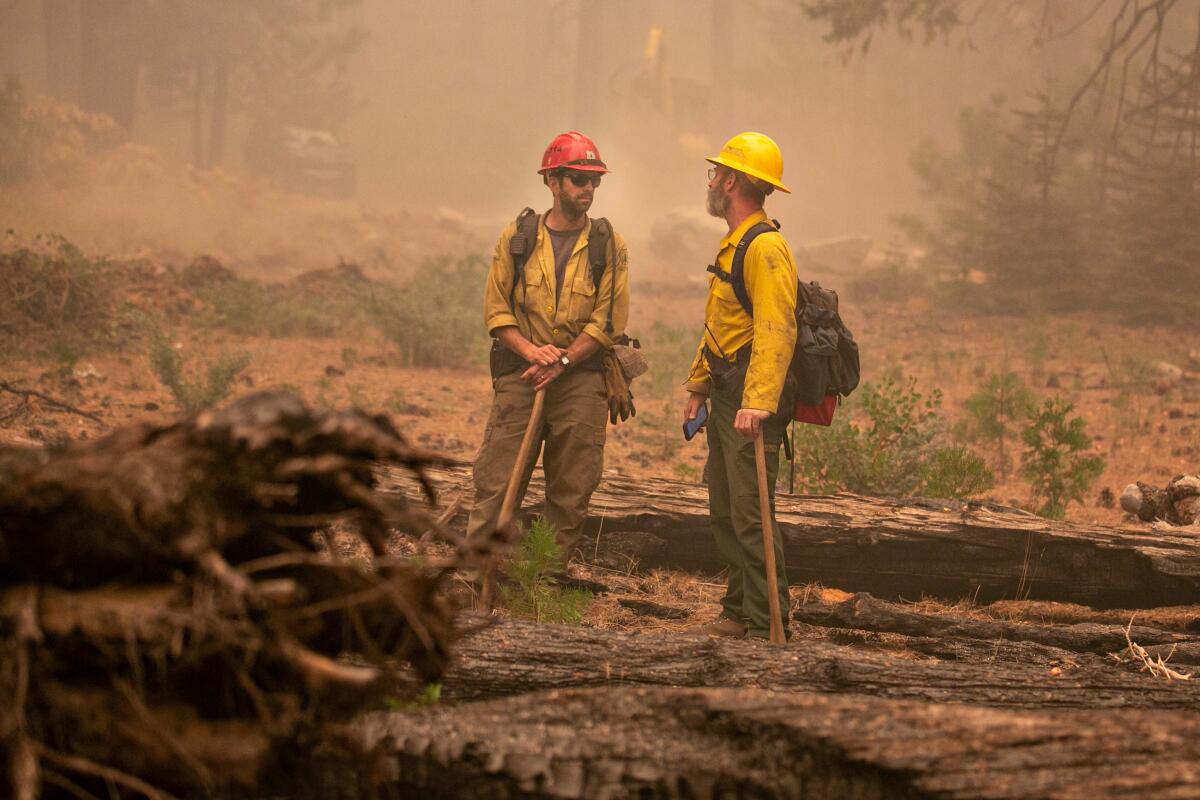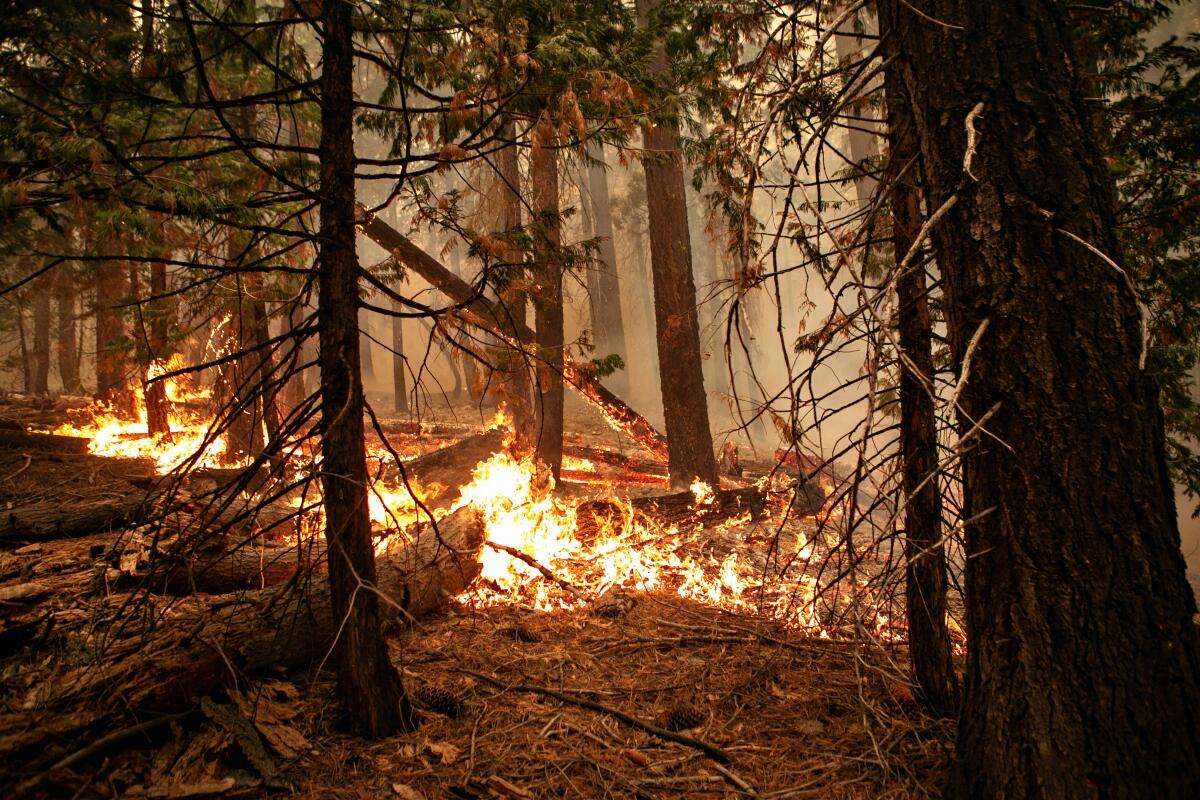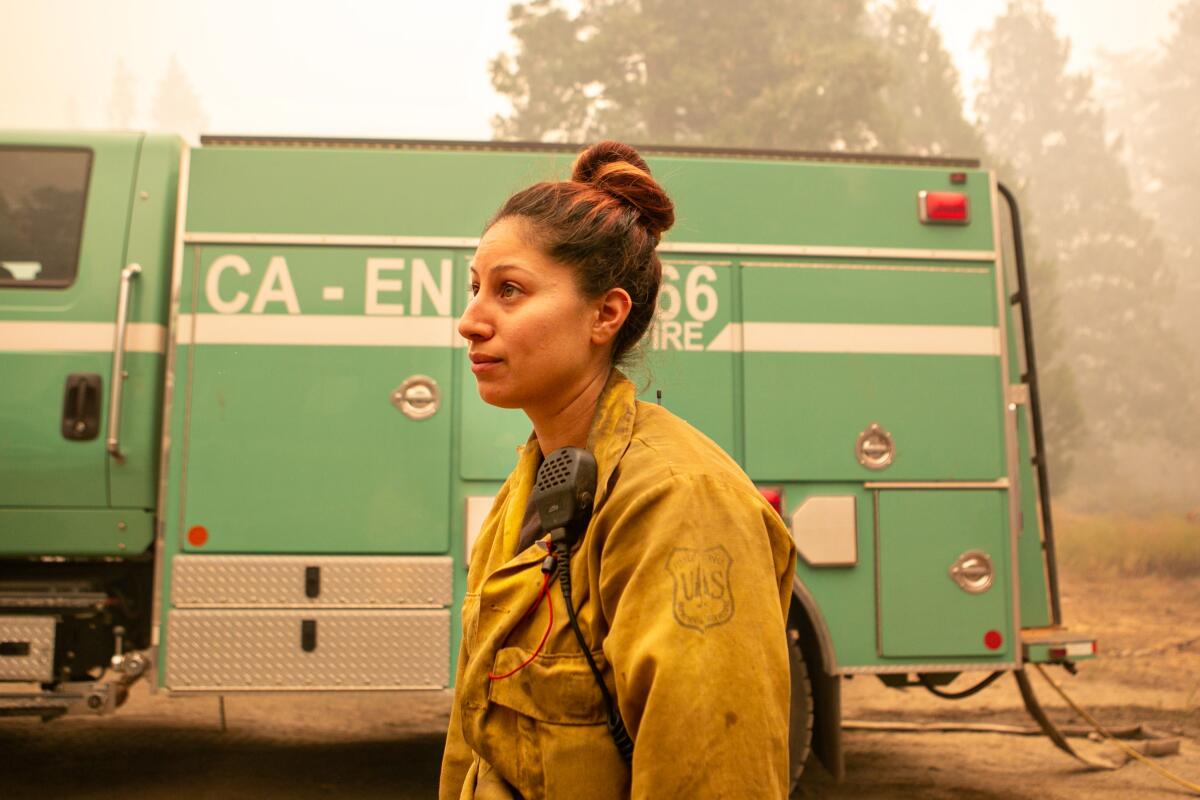On the front lines of desperate battle to keep Caldor fire from hitting Lake Tahoe

- Share via
STRAWBERRY, Calif. — Heading west on Highway 50 from the tiny town of Strawberry was an exercise in blind faith Friday, as even the nearest of pine trees were obscured by sickly yellow smoke spewing from the nearby Caldor fire.
Charred trees and fallen rocks dotted the roadside, and small spot fires seemed agitated by even the slightest hint of wind.
But, despite the eyeball-burning air, crews were working fast and hard with one major goal in mind: to prevent the raging, 143,000-acre fire from sweeping down into the basin of South Lake Tahoe.
“We’re trying to keep it west of [Highway] 89, and definitely trying to keep it from Lake Tahoe,” said Rosie Smith, an assistant engine operator with the U.S. Forest Service. “It’s just the extreme fire behavior that we’ve had over the last few weeks has made it difficult for us really to get ahead of the thing.”
Nearly 3,000 personnel are battling the fire, which remained only 12% contained Friday, and many are focused on the area near Lake Tahoe.

Crews along the road leading to Twin Bridges were laying handlines and driving bulldozers through forested terrain, hardly seeming to notice the swirling ash and smoke. But in the stand to save Lake Tahoe, officials said there are several factors working in their favor — including less fire-friendly topography, slowing winds and a large granite ridge between the town and the flames.
But climate-driven wildfire behavior has been so erratic this year that nearly anything is possible.
“Our winds are going to be lower today than they were yesterday, but we also have high temperatures and decreased humidity,” said Jason Hunter, a Caldor fire information officer. “We’re focusing a lot of efforts up here, a lot of resources on this side of the fire.”
As he spoke, simmering flames on the forest floor behind him caught a gust of wind and roared up the spine of a nearby tree. The stony ridge between the fire and the basin may be the best opportunity to get ahead of the blaze, he said.
“The granite gives us the benefit of less fuels, so it slows the rate of spread for the fire and gives us the chance to make a direct attack, potentially,” he said. But while the ridge could help slow the fire’s progress, it’s not impossible for the flames to jump it — especially if winds pick up again.

That’s why crews are also banking on topography to assist: The other side of the ridge is a downhill slope that leads into the Tahoe Basin, and wildfires don’t move downhill as quickly as they move up, Hunter said.
Also of potential benefit is a change in ecology, according to engine Capt. Mike Loeffler.
The fuel burns right through the manzanita brush, ponderosa pine and cedar trees that cover the area, Loeffler said. “Up there near the ridge, you’ve got a lot of fir trees and a lot more spare open areas because it’s a higher elevation. There’s more opportunities to try to catch [the fire].”
And while Tahoe remains a primary focus, crews also said the most imminent threat is to Strawberry, as well as about 50 cabins in a nearby tract of Eldorado National Forest, which they were working quickly to protect.

And while most were confident that they could get a handle on the fire before it reached more homes or structures, they also acknowledged that California’s fire season has been anything but predictable this year.
“We saw a big flare-up earlier, and we could feel the heat through our bus,” said Patrick McLaughlin, a firefighter with the Eel River crew of the California Department of Corrections and Rehabilitation. McLaughlin said the Caldor fire was his 25th fire in two seasons, and noted that it is hasn’t been uncommon to see embers jump over hand or bulldozer lines, allowing the fire to spread.

Capt. Casey Hoffman with the El Dorado National Forest said firefighting work has been exceptionally busy the last five years as the state has gotten drier and hotter. “There’s a lot more fires, and a lot of wind-driven fires,” he said, as he leaned on his shovel for a brief rest before heading back downhill to the line. “Everything is receptive.”
But with Cal Fire Chief Thom Porter this week proclaiming the Caldor fire as the nation’s top priority, fire crews were optimistic that they will have the resources they need and the ability to prevent a worst-case scenario. They just hope they can find a way to turn that corner soon.
“We’re doing the best we can with what we have,” said Smith, the assistant engine operator. “There’s other forests that are having just as hard of a time, and there’s only so many of us.”
More to Read
Sign up for Essential California
The most important California stories and recommendations in your inbox every morning.
You may occasionally receive promotional content from the Los Angeles Times.














